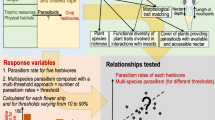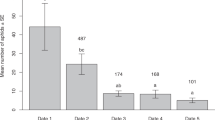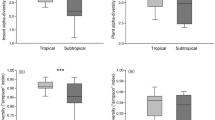Abstract
Variation in the number of phytophagous insect species associated with different plant hosts has been examined for many insect and plant groups1–7. Here we extend such analyses to focus on the number of parasitoids and hyperparasitoids attacking British phytophagous insects. First, we examine a number of variables describing characteristics of the herbivores and their host plants. Then we construct a multiple regression model to order the variables and determine how much of the variance in parasitoid species richness we can account for. We find that host insects' feeding niche, geographical extent of study ('range'), the architecture of plants on which hosts occur and the taxonomic isolation of host insects each significantly affects the number of associated parasitoid species per host species, but only the first two variables were significant in the multiple regression. The final model accounts for 22% of the variance in parasitoid richness.
This is a preview of subscription content, access via your institution
Access options
Subscribe to this journal
Receive 51 print issues and online access
$199.00 per year
only $3.90 per issue
Buy this article
- Purchase on Springer Link
- Instant access to full article PDF
Prices may be subject to local taxes which are calculated during checkout
Similar content being viewed by others
References
Opler, P. A. Am. Nat. 62, 67–73 (1974).
Lawton, J. H. & Schroder, D. Nature 265, 137–140 (1977).
Lawton, J. H. & Price, P. W. J. Anim. Ecol. 48, 619–637 (1979).
Claridge, M. F. & Wilson, M. R. Ecol. Entomol. 7, 19–30 (1982).
Kennedy, C. E. J. & Southwood, T. R. E. J. Anim. Ecol. 53, 455–478 (1984).
Godfray, H. C. J. Ecol. Entomol. 9, 163–168 (1984).
Strong, D. R., Lawton, J. H. & Southwood, T. R. E. Insects on Plants (Blackwell, Oxford, 1984).
Price, P. W. Evolutionary Biology of Parasites (Princeton University Press, 1980).
Rey, J. R., McCoy, E. D. & Strong, D. R. Jr, Am. Nat. 117, 611–622 (1981).
Askew, R. R. & Shaw, M. R. in Insect Parasitoids (eds Waage, J. & Greathead, D.) 225–264 (Academic, London, 1986).
Ball, J. C. & Dahlsten, D. L. Can. Ent. 105, 1453–1464 (1973).
Shaw, M. R. & Askew, R. R. in A Dipterist's Handbook (ed. Stubbs, A. & Chandler, P.) 164–171 (The Amateur Entomologist, vol. 15, 1979).
Kloet, G. S. & Hincks, W. D. A Checklist of British Insects. Part 1: Small Orders and Hemiptera (Handbk. Ident. Br. Insects, Roy. Entomol. Soc. Lond., London, 1964).
Kloet, G. S. & Hincks, W. D. A Checklist of British Insects. Part 2. Lepidoptera (Handbk. Ident. Br. Insects, Roy. Entomol. Soc. Lond., London, 1972).
Kloet, G. S. & Hincks, W. D., A Checklist of British Insects. Part 5. Diptera and Siphonaptera. (Handbk. Ident. Br. Insects, Roy. Entomol. Soc. Lond., London, 1976).
Kloet, G. S. & Hincks, W. D., A Checklist of British Insects. Part 3. Coleoptera and Strepsiptera (Handbk. Ident. Br. Insects, Roy. Entomol. Soc. Lond., London, 1977).
Kloet, G. S. & Hincks, W. D., A Checklist of British Insects. Part 4. Hymenoptera. (Handbk. Ident. Br. Insects, Roy. Entomol. Soc. Lond., London, 1978).
Stevens, G. C. Am. Nat. 128, 35–46 (1986).
Connor, E. F. & McCoy, E. D. Am. Nat. 113, 791–833 (1979).
Karban, R. & Ricklefs, R. E. Ecology 64, 636–641 (1983).
Lawton, J. H. A. Rev. Ent. 28, 23–39 (1983).
Askew, R. R. J. Anim. Ecol 49, 817–829 (1980).
DeBach, P. Biological Control of Insect Pests and Weeds (Chapman and Hall, London, 1964).
Starý, P. Biology of Aphid Parasites {Hymenoptera: Aphidiidae) With Respect to Integrated Control (Junk, The Hague, 1970).
Price, P. W. et al. A. Rev. Ecol. Syst. 11, 41–65 (1980).
Vinson, S. B. in Chemical Ecology of Insects (eds Bell, W. J. & Carde, R. T.) 205–232 (Chapman and Hall, London, 1984).
Cornell, H. V. Ecology 66, 1247–1260 (1985).
Jefferies, M. J. & Lawton, J. H. Biol. J. Linn. Soc. 23, 269–286 (1986).
Lawton, J. H. in Insect Parasitoids (eds Waage, J. & Greathead, D.) 265–287 (Academic, London, 1986).
Author information
Authors and Affiliations
Rights and permissions
About this article
Cite this article
Hawkins, B., Lawton, J. Species richness for parasitoids of British phytophagous insects. Nature 326, 788–790 (1987). https://doi.org/10.1038/326788a0
Received:
Accepted:
Published:
Issue Date:
DOI: https://doi.org/10.1038/326788a0
This article is cited by
-
Taxonomy and Biological Control: New Challenges in an Old Relationship
Neotropical Entomology (2023)
-
The Amazon and Its Biodiversity: a Source of Unexplored Potential Natural Enemies for Biological Control (Predators and Parasitoids)
Neotropical Entomology (2023)
-
Influence of elevation gradient on Cynipid galls and their associated insect communities: the case of Quercus rugosa (Fagaceae)
Arthropod-Plant Interactions (2022)
-
Trophic interaction and diversity of cavity-nesting bees and wasps (Hymenoptera: Aculeata) in Atlantic forest fragments and in adjacent matrices
Apidologie (2019)
-
Quantifying the unquantifiable: why Hymenoptera, not Coleoptera, is the most speciose animal order
BMC Ecology (2018)
Comments
By submitting a comment you agree to abide by our Terms and Community Guidelines. If you find something abusive or that does not comply with our terms or guidelines please flag it as inappropriate.



